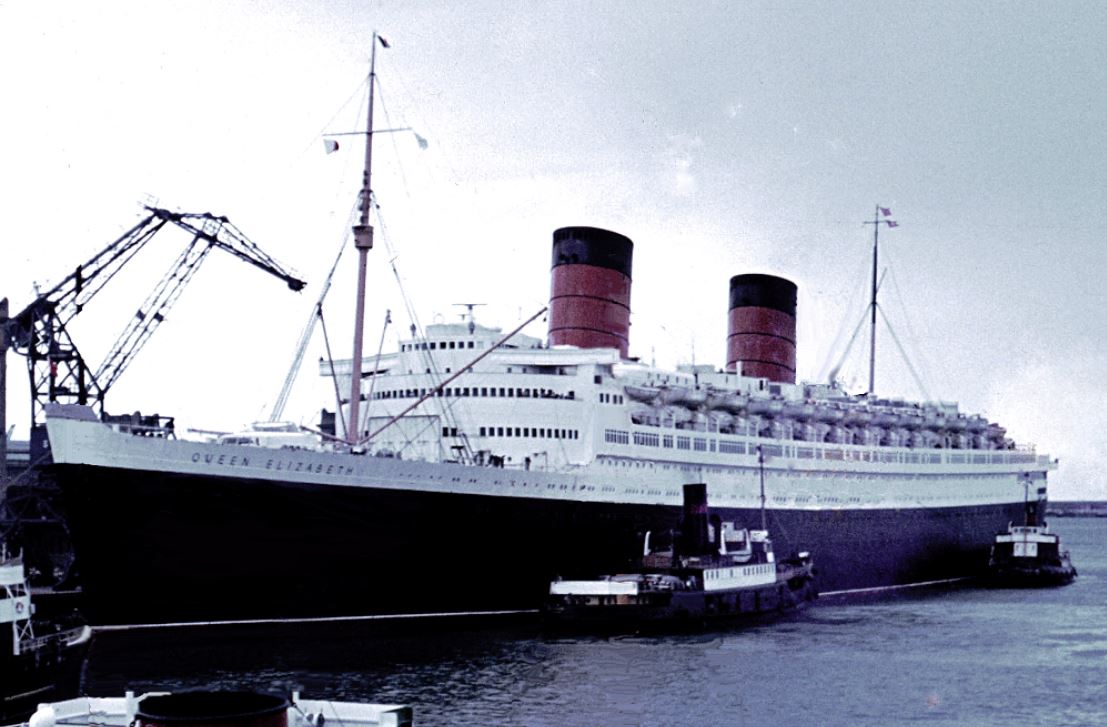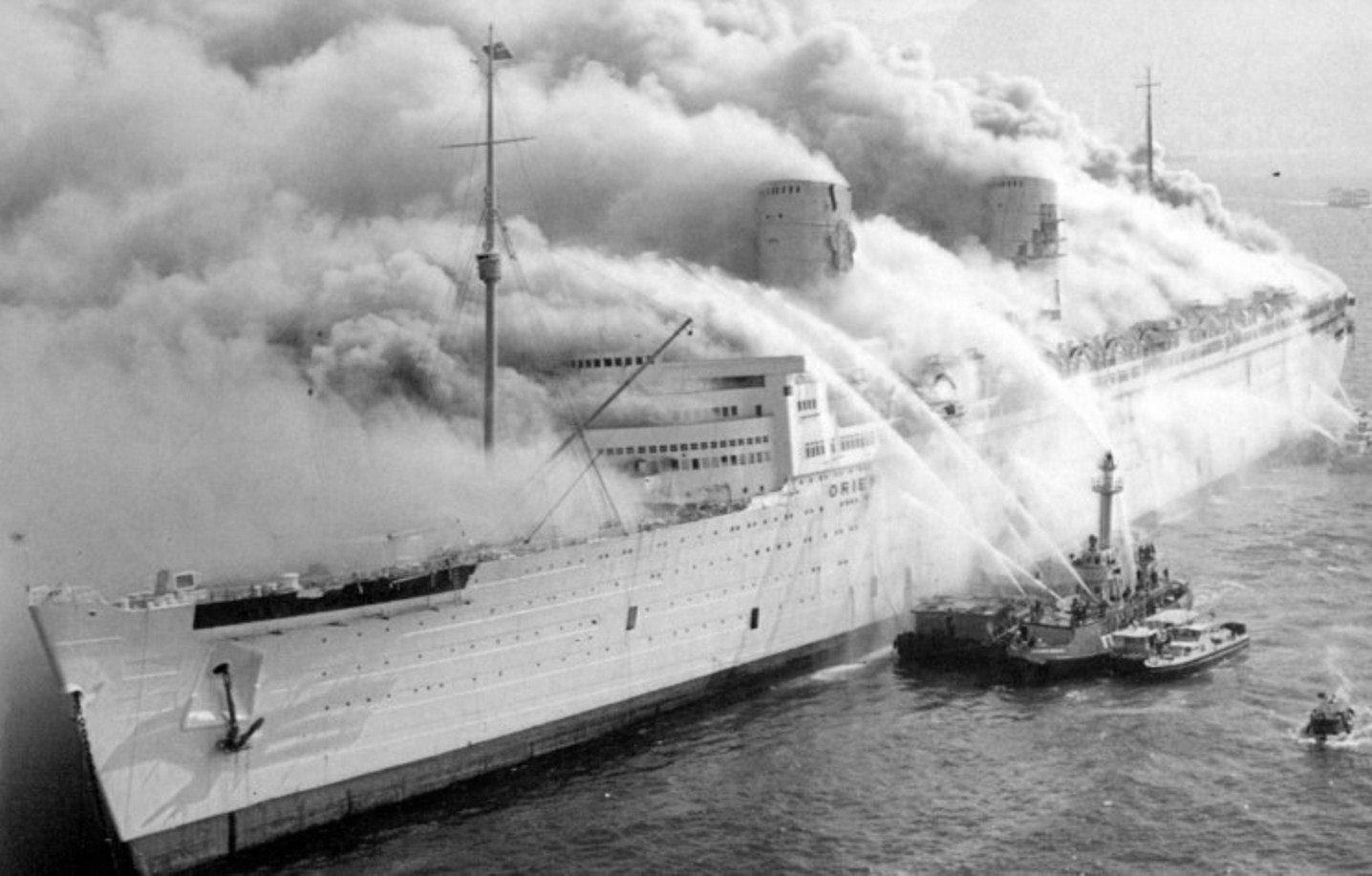Difference between revisions of "HMT Queen Elizabeth"
From Our Contribution
(→Soldiers carried) |
|||
| Line 1: | Line 1: | ||
| − | {{Infobox | + | {{Infobox ship |
| − | | | + | | image = [[File:RMS_Queen_Elizabeth.jpg]] |
| − | |||
| − | |||
| − | |||
| − | |||
| − | |||
| caption = | | caption = | ||
| − | | | + | | image2 = [[File:RMS_Queen_Elizabeth_1.jpg]] |
| caption2 = | | caption2 = | ||
| + | | shipname = RMS Queen Elizabeth | ||
| + | | shipowner = Cunard White Star Line Ltd., Liverpool | ||
| + | | shipbuilder = John Brown and Company, Clydebank. | ||
| + | | shipyardnumber = 552 | ||
| + | | shiplaunched = 27 Sep 1938 | ||
| + | | shipcompleted = February 1940 | ||
| + | | shipinservice = 1940 | ||
| + | | shipoutofservice = 1972 | ||
| + | | shipinservice2 = | ||
| + | | shipoutofservice2 = | ||
| + | | shipreclassified = | ||
| + | | shipID = | ||
| + | | shipfate = Burned out, capsized and sank at Hong Kong while under refit. Broken up. | ||
| + | | shiptype = Ocean Liner | ||
| + | | shiptonnage = 83,673 tons | ||
| + | | shiplength = 1031 ft (314.25m) | ||
| + | | shipbeam = 118.6 ft (36.12m) | ||
| + | | shipdepth = 68.4 ft (20.83) draft 39.0 ft (11.89m) | ||
| + | | shippropulsion = 4 screws | ||
| + | | shipspeed = 28.5 knots (52.78 km/h) | ||
| + | | shipcapacity = 822 1st, 668 cabin, and 798 tourist class. | ||
| + | }} | ||
| − | |||
| − | |||
| − | |||
| − | |||
| − | + | ==Remarks== | |
| − | + | Built for the White Cunard Line. Elaborate security precautions were taken to mask her first voyage from the shipyards to New York. Cunard received a letter from Winston Churchill, then First Lord of the Admiralty, ordering the ship to leave Clydeside as soon as possible and "to keep away from the British Isles as long as the order was in force". ''Queen Elizabeth'' left the port of New York on 13 November 1940 for Singapore to receive her troopship conversion. | |
| − | |||
| − | |||
| − | |||
| − | |||
| − | + | Initially she carried Australian troops to theatres of operation in Asia and Africa. After 1942, the two Queens were relocated to the North Atlantic for the transportation of American troops to Europe. | |
| − | |||
| − | |||
| − | |||
| − | |||
| − | |||
| − | |||
| − | |||
| − | |||
| − | |||
| − | |||
| − | |||
| − | |||
| − | |||
| + | Following the end of the Second World War, ''Queen Elizabeth'' was refitted and furnished as an ocean liner. ''Queen Elizabeth'' finally entered passenger service, allowing Cunard White Star to launch the long planned two-ship weekly service to New York. The ship ran aground on a sandbank off Southampton on 14 April 1947 and was re-floated the following day. In 1955, during an annual overhaul at Southampton, England, ''Queen Elizabeth'' was fitted with underwater fin stabilisers to smooth the ride in rough seas. On 29 July 1959, she was in a collision with the American freighter ''American Hunter'' in foggy conditions in New York Harbour and was holed above the waterline. | ||
| − | |||
| − | In 1968, Queen Elizabeth was sold to a group of American businessmen from a company called The Queen Corporation (which was 85% owned by Cunard and 15% by them). The new company intended to operate the ship as a hotel and tourist attraction in Port Everglades, Florida, similar to the planned use of Queen Mary in Long Beach, California. This venture failed, and the vessel was towed out of the harbour to Asia to become a floating university after being sold at auction in 1970 to Hong Kong tycoon Tung Chao Yung. The ship was now under Chinese ownership and it was decided to sail her to Hong Kong. This proved to be problematic as the ships engines and boilers were in poor condition after several years of neglect. Near the completion of the £5 million conversion, the vessel caught fire on 9 January 1972. The ship was completely destroyed by the fire, and the water sprayed on her by fireboats caused the burnt wreck to capsize and sink in Hong Kong's Victoria Harbour. The vessel was finally declared a shipping hazard and dismantled for scrap between 1974 and 1975. | + | In 1968, ''Queen Elizabeth'' was sold to a group of American businessmen from a company called The Queen Corporation (which was 85% owned by Cunard and 15% by them). The new company intended to operate the ship as a hotel and tourist attraction in Port Everglades, Florida, similar to the planned use of ''Queen Mary'' in Long Beach, California. This venture failed, and the vessel was towed out of the harbour to Asia to become a floating university after being sold at auction in 1970 to Hong Kong tycoon Tung Chao Yung. The ship was now under Chinese ownership and it was decided to sail her to Hong Kong. This proved to be problematic as the ships engines and boilers were in poor condition after several years of neglect. Near the completion of the £5 million conversion, the vessel caught fire on 9 January 1972. The ship was completely destroyed by the fire, and the water sprayed on her by fireboats caused the burnt wreck to capsize and sink in Hong Kong's Victoria Harbour. The vessel was finally declared a shipping hazard and dismantled for scrap between 1974 and 1975. |
==Soldiers carried== | ==Soldiers carried== | ||
===Convoy US13 Fremantle to Suez via Ceylon 8 November 1941 - 22 November 1941=== | ===Convoy US13 Fremantle to Suez via Ceylon 8 November 1941 - 22 November 1941=== | ||
| − | *[[Ralph Godfrey]] | + | * [[Ralph Godfrey]] |
| − | + | * † [[Alan Wesley Hain]] RAAF | |
| − | *† [[Alan Wesley Hain]] RAAF | ||
[[Category:Ships]] | [[Category:Ships]] | ||
Revision as of 00:26, 5 November 2021
Remarks
Built for the White Cunard Line. Elaborate security precautions were taken to mask her first voyage from the shipyards to New York. Cunard received a letter from Winston Churchill, then First Lord of the Admiralty, ordering the ship to leave Clydeside as soon as possible and "to keep away from the British Isles as long as the order was in force". Queen Elizabeth left the port of New York on 13 November 1940 for Singapore to receive her troopship conversion.
Initially she carried Australian troops to theatres of operation in Asia and Africa. After 1942, the two Queens were relocated to the North Atlantic for the transportation of American troops to Europe.
Following the end of the Second World War, Queen Elizabeth was refitted and furnished as an ocean liner. Queen Elizabeth finally entered passenger service, allowing Cunard White Star to launch the long planned two-ship weekly service to New York. The ship ran aground on a sandbank off Southampton on 14 April 1947 and was re-floated the following day. In 1955, during an annual overhaul at Southampton, England, Queen Elizabeth was fitted with underwater fin stabilisers to smooth the ride in rough seas. On 29 July 1959, she was in a collision with the American freighter American Hunter in foggy conditions in New York Harbour and was holed above the waterline.
In 1968, Queen Elizabeth was sold to a group of American businessmen from a company called The Queen Corporation (which was 85% owned by Cunard and 15% by them). The new company intended to operate the ship as a hotel and tourist attraction in Port Everglades, Florida, similar to the planned use of Queen Mary in Long Beach, California. This venture failed, and the vessel was towed out of the harbour to Asia to become a floating university after being sold at auction in 1970 to Hong Kong tycoon Tung Chao Yung. The ship was now under Chinese ownership and it was decided to sail her to Hong Kong. This proved to be problematic as the ships engines and boilers were in poor condition after several years of neglect. Near the completion of the £5 million conversion, the vessel caught fire on 9 January 1972. The ship was completely destroyed by the fire, and the water sprayed on her by fireboats caused the burnt wreck to capsize and sink in Hong Kong's Victoria Harbour. The vessel was finally declared a shipping hazard and dismantled for scrap between 1974 and 1975.
Soldiers carried
Convoy US13 Fremantle to Suez via Ceylon 8 November 1941 - 22 November 1941
- Ralph Godfrey
- † Alan Wesley Hain RAAF

